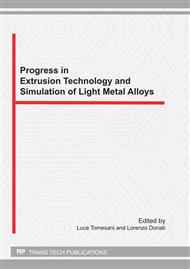p.181
p.189
p.197
p.205
p.215
p.223
p.233
p.241
p.249
Effect of Liquid Nitrogen Die Cooling on Extrusion Process Conditions
Abstract:
In the paper, a die for the production of a complex hollow profile made by AA6060 alloy on an industrial 2500 ton press has been manufactured and tested under strict monitored conditions. In particular 5 thermocouples were placed in proximity of interesting positions inside the die: 3 next to the bearings and two near the welding chambers. A self-calibrated pyrometer was used for the temperature monitoring of profile. Press loads, ram speeds and container temperatures were continuously recorded directly from the press system. Six billets were initially extruded in order to reach a steady state condition being the last three used as industrial benchmark for the 2011 edition of the ICEB conference. Then the nitrogen was completely and partially opened and the evolution of the temperature in the die and in the profile recorded together with the process load. The effect on bearing temperature was extreme, in particular in proximity of nitrogen inlet, while almost no change in welding chamber thermocouples and in the process load was revealed.
Info:
Periodical:
Pages:
215-222
Citation:
Online since:
September 2011
Keywords:
Price:
Сopyright:
© 2012 Trans Tech Publications Ltd. All Rights Reserved
Share:
Citation:


